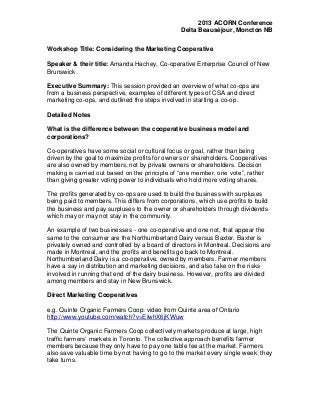
Considering the Marketing Co-operative with Amanda Hachey
- 1. 2013 ACORN Conference Delta Beauséjour, Moncton NB Workshop Title: Considering the Marketing Cooperative Speaker & their title: Amanda Hachey, Co-operative Enterprise Council of New Brunswick Executive Summary: This session provided an overview of what co-ops are from a business perspective, examples of different types of CSA and direct marketing co-ops, and outlined the steps involved in starting a co-op. Detailed Notes What is the difference between the cooperative business model and corporations? Co-operatives have some social or cultural focus or goal, rather than being driven by the goal to maximize profits for owners or shareholders. Cooperatives are also owned by members, not by private owners or shareholders. Decision making is carried out based on the principle of “one member, one vote”, rather than giving greater voting power to individuals who hold more voting shares. The profits generated by co-ops are used to build the business with surpluses being paid to members. This differs from corporations, which use profits to build the business and pay surpluses to the owner or shareholders through dividends which may or may not stay in the community. An example of two businesses - one co-operative and one not, that appear the same to the consumer are the Northumberland Dairy versus Baxter. Baxter is privately owned and controlled by a board of directors in Montreal. Decisions are made in Montreal, and the profits and benefits go back to Montreal. Northumberland Dairy is a co-operative, owned by members. Farmer members have a say in distribution and marketing decisions, and also take on the risks involved in running that end of the dairy business. However, profits are divided among members and stay in New Brunswick. Direct Marketing Cooperatives e.g. Quinte Organic Farmers Coop: video from Quinte area of Ontario http://www.youtube.com/watch?v=EIwhX6jKWuw The Quinte Organic Farmers Coop collectively markets produce at large, high traffic farmers’ markets in Toronto. The collective approach benefits farmer members because they only have to pay one table fee at the market. Farmers also save valuable time by not having to go to the market every single week: they take turns.
- 2. 2013 ACORN Conference Delta Beauséjour, Moncton NB e.g. Really Local Harvest Cooperative Really Local Harvest is another example of a farmer member coop. All members are local, independent farmers who collectively manage a market in Dieppe, NB. The coop came about because many small farmers were competing with each other heavily and driving prices down in price wars. Now the farmers continue to run their own independent businesses, but are transparent about their marketing plans, and collectively develop and manage the farmers’ market. e.g. Organic Meadow Dairy Cooperative The presenter shared a video from www.coopscanada.coop on the governance of cooperatives. Ontario’s very successful dairy coop, Organic Meadow, was used as a case study. Generally, governance begins with an elected board of volunteers. Eventually, as a cooperative grows, it may choose to hire employees to govern and the original volunteers have to step away. This can be a challenging transition and coops must continually revisit their missions to ensure that they are meeting more than a single bottom line. How to get started To start a cooperative you must assemble a group of interested people and identify needs. Three people is the minimum number required to create a cooperative. Consider the market demand for your cooperative, as well as the social, cultural or environmental need the cooperative would be serving. It is highly advisable to conduct a pre-feasibility study to test whether or not your idea holds weight in the market. If the idea survives this stage, organize a public meeting and carry out a more detailed feasibility study. Next determine and organize the nature of the cooperative association. Will it be a consumer coop, a producer coop, a worker coop, or a combination of these types? Discuss the business side of the enterprise. Once the above steps are completed, hold an initial General Meeting. The process from idea to General Meeting can take anywhere from 6 months to 4 years. Contact your provincial Cooperative Enterprise Council for more information and assistance!